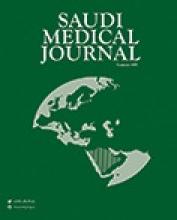Abstract
OBJECTIVES: To estimate the direct medical costs associated with ischemic heart disease (IHD) at Prince Sultan Cardiac Center (PSCC) in Riyadh, Saudi Arabia.
METHODS: This is a prevalence-based prospective observational cost of illness study conducted in PSCC, Riyadh, Kingdom of Saudi Arabia between April and June 2009. All patients diagnosed or suspected of having IHD at admission were included. They were followed up until discharge, or performing coronary artery bypass graft (CABG), or changing diagnosis. Clinical data were extracted from the patients' computerized database, and combined with the unit cost of services to calculate costs.
RESULTS: A total of 205 patients were recruited and diagnosed with stable angina (SA, 47.8%), unstable angina (USA, 24.4%), ST-segment elevation myocardial infarction (STEMI, 19.5%), and non-ST-segment elevation myocardial infarction (NSTEMI, 8.3%). Most of the patients were Saudi males, aged between 40-75 years. Eighty-seven percent of patients had 2 or more co-morbidities, and 32% of the patients were obese. The average cost was 40,164 Saudi Riyals (SAR)/patient (US$10,710). Medication contributed the lowest in the costs (3.2%). A cost associated with SA was SAR33,991, USA was SAR35,107, NSTEMI was SAR46,585, and STEMI was SAR58,877 per patient. The lowest mean hospital length of stay was 6.5 days with SA. The average length of stay increased with the number of co-morbidities from 5.67 days (no co-morbidity) to 11.25 days (6 co-morbidities).
CONCLUSIONS: The IHD is of high economic burden in the country. Among IHD types studied, the resource consumption associated to STEMI was the highest in terms of costs, and hospital length of stay.
- Copyright: © Saudi Medical Journal
This is an open-access article distributed under the terms of the Creative Commons Attribution-Noncommercial-Share Alike 3.0 Unported, which permits unrestricted use, distribution, and reproduction in any medium, provided the original work is properly cited.






